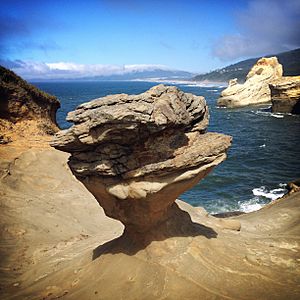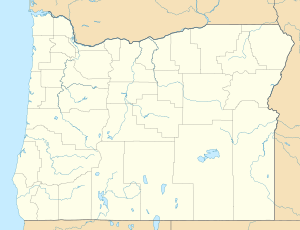Duckbill (rock formation) facts for kids
Quick facts for kids Duckbill |
|
|---|---|

The rock formation on August 27, 2014
|
|
| Location | Tillamook County, Oregon |
| Coordinates | 45°13′04″N 123°58′46″W / 45.21777°N 123.97934°W |
| Elevation | 39 feet (12 m) |
| Geology | Sandstone hoodoo |
The Duckbill was a unique rock formation located at Cape Kiwanda State Natural Area in Oregon, a state in the United States. It was a type of rock called a hoodoo, which is a tall, thin spire of rock that sticks up from the ground. The Duckbill was made of sandstone and looked like a duck's bill, which is how it got its name.
This special rock was a very popular spot for tourists visiting the Oregon Coast. Many people loved to take pictures of it because it was so unusual and beautiful. Sadly, the Duckbill was knocked over by a group of teenagers on August 29, 2016.
Contents
What Was the Duckbill?
The Duckbill was a natural rock sculpture. It stood about 39 feet (12 meters) tall. It was formed over many years by wind and water wearing away softer rock, leaving behind the harder sandstone. This process is called Erosion. The Duckbill was a great example of how nature can create amazing shapes.
Why Was it Special?
The Duckbill was a famous landmark. It was a symbol of the Oregon Coast's natural beauty. People from all over the world came to see it. It was often featured in photos and travel guides. Its unique shape made it a favorite for photographers.
What Happened to the Duckbill?
On August 29, 2016, a group of teenagers pushed over the Duckbill. They filmed themselves doing it. The rock formation broke into pieces. This act was considered vandalism, which means purposely damaging something.
Why Did They Topple It?
The teenagers who pushed over the Duckbill said they did it because they thought it was dangerous. They claimed a friend had hurt their leg near the rock. They believed they were helping by removing a safety risk.
However, park officials disagreed. Chris Havel, from the Oregon Parks and Recreation Department, explained that the Duckbill area was fenced off. There were also signs warning visitors to stay away. He said that people had to intentionally move the fence wires and crawl through to get close to the rock. This showed that the area was clearly marked as off-limits for safety reasons.
The loss of the Duckbill was very sad for many people. It was a natural wonder that had been enjoyed by visitors for a long time.


